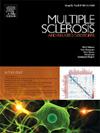Rituximab regimens and lymphocyte counts in patients with neuromyelitis optica: A systematic review
IF 2.9
3区 医学
Q2 CLINICAL NEUROLOGY
引用次数: 0
Abstract
Objective
To evaluate the utility of peripheral blood B-cell counts, specifically CD19+ and CD27+ lymphocytes by flow cytometry, in patients with neuromyelitis optica (NMO) treated with rituximab.
Methods
A systematic review was conducted following the PRISMA guidelines. Searches were performed in PubMed, LILACS, Cochrane, and ClinicalTrials databases up to July 2024, including studies in English, Spanish, and French. Studies were selected based on predefined eligibility criteria, and data extraction was performed independently by two reviewer teams. Risk of bias was assessed using the JBI Critical Appraisal Tool, and the certainty of evidence was evaluated with the GRADE methodology.
Results
A total of 3325 studies were identified, of which 22 met the inclusion criteria, analyzing 633 patients. Most studies used rituximab induction schemes of 375 mg/m² weekly (46%) or 1 g biweekly (38%). Retreatment protocols varied widely, and 84.6% of studies measured CD19+ cells, while 42.3 % also included CD27+ memory B cells. The most common depletion thresholds were <1% for CD19+ and <0.05% for CD27+. Repopulation occurred between 2.5 and 12.72 months, with 26% peaking at 6 months. Recurrent disease was reported in 200 patients (31.5%), with 64.5% of relapses associated with B-cell repopulation. However, 35% of relapses occurred without B-cell return. The quality of evidence was limited due to methodological heterogeneity, small sample sizes, and variability in monitoring protocols.
Conclusión
B-cell repopulation appears to be temporally associated with relapses in NMO, highlighting the potential value of CD19+ and CD27+ monitoring by flow cytometry to guide retreatment strategies. However, relapses also occurred in the absence of repopulation, suggesting other pathophysiological mechanisms. There is a pressing need for standardized treatment protocols and prospective, multicenter studies to define the optimal use of B-cell monitoring in clinical practice.
利妥昔单抗方案和淋巴细胞计数在视神经脊髓炎患者:系统回顾。
目的:评价流式细胞术检测外周血b细胞计数,特别是CD19+和CD27+淋巴细胞在利妥昔单抗治疗视神经脊髓炎(NMO)患者中的应用价值。方法:按照PRISMA指南进行系统评价。检索在PubMed, LILACS, Cochrane和ClinicalTrials数据库中进行,截至2024年7月,包括英语,西班牙语和法语的研究。研究是根据预定义的资格标准选择的,数据提取由两个审查小组独立进行。使用JBI关键评估工具评估偏倚风险,使用GRADE方法评估证据的确定性。结果:共纳入3325项研究,其中22项符合纳入标准,共纳入633例患者。大多数研究使用每周375 mg/m²(46%)或每两周1 g(38%)的利妥昔单抗诱导方案。再治疗方案差异很大,84.6%的研究测量了CD19+细胞,而42.3%的研究还包括CD27+记忆B细胞。最常见的消耗阈值是
本文章由计算机程序翻译,如有差异,请以英文原文为准。
求助全文
约1分钟内获得全文
求助全文
来源期刊

Multiple sclerosis and related disorders
CLINICAL NEUROLOGY-
CiteScore
5.80
自引率
20.00%
发文量
814
审稿时长
66 days
期刊介绍:
Multiple Sclerosis is an area of ever expanding research and escalating publications. Multiple Sclerosis and Related Disorders is a wide ranging international journal supported by key researchers from all neuroscience domains that focus on MS and associated disease of the central nervous system. The primary aim of this new journal is the rapid publication of high quality original research in the field. Important secondary aims will be timely updates and editorials on important scientific and clinical care advances, controversies in the field, and invited opinion articles from current thought leaders on topical issues. One section of the journal will focus on teaching, written to enhance the practice of community and academic neurologists involved in the care of MS patients. Summaries of key articles written for a lay audience will be provided as an on-line resource.
A team of four chief editors is supported by leading section editors who will commission and appraise original and review articles concerning: clinical neurology, neuroimaging, neuropathology, neuroepidemiology, therapeutics, genetics / transcriptomics, experimental models, neuroimmunology, biomarkers, neuropsychology, neurorehabilitation, measurement scales, teaching, neuroethics and lay communication.
 求助内容:
求助内容: 应助结果提醒方式:
应助结果提醒方式:


